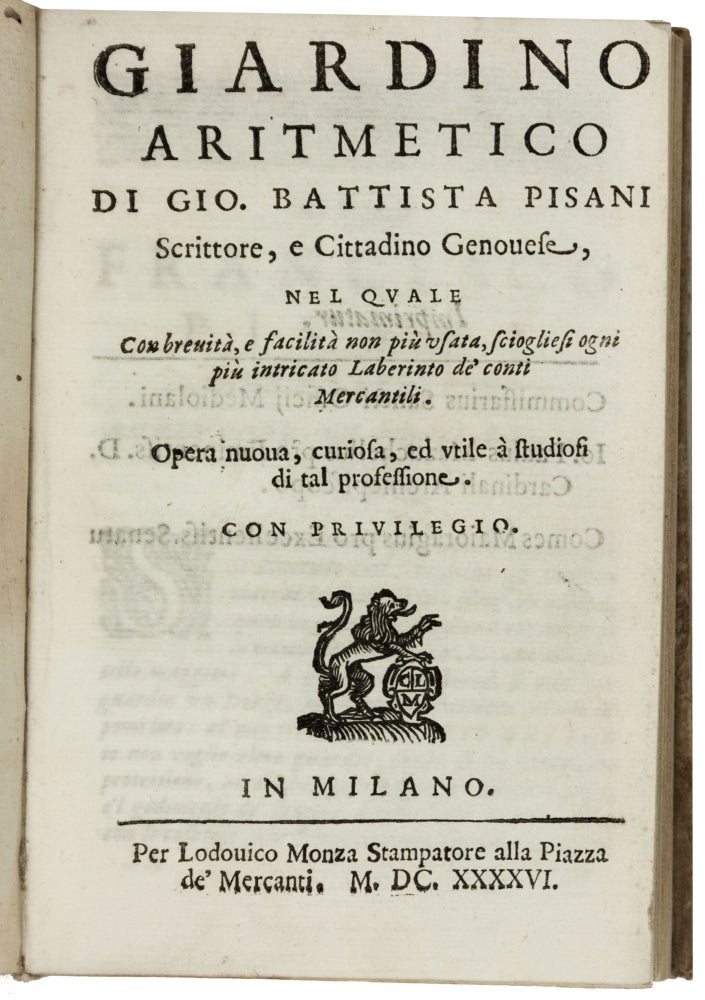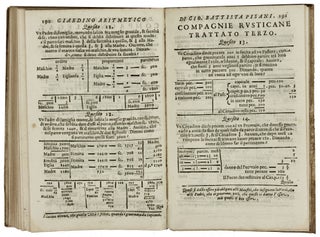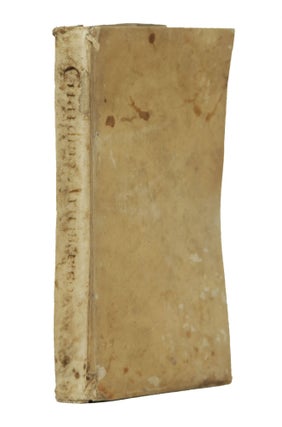Giardino aritmetico.
8vo [17.1 x 11.1 cm], (5) ff., 214 pp. (final page erroneously numbered 114). Bound in contemporary vellum, title in ink on spine; minor staining to upper cover, lower cover slightly cockled. Internally very fresh.
Very rare first and only edition of a practical handbook of business mathematics by Giovanni Battista Pisani (born circa 1606), who promises on the work’s title page to help readers “solve the intricate Labyrinth of mercantile accounting.” Pisani - who has an unusual literary touch - dedicates his Giardino aritmetico not to some grand Padrone, but to his brother Francesco, remarking that whereas the Garden of Hesperides had been guarded by a fearsome dragon, his Arithmetical Garden would be open to all who wish to take of its fruits. The small-format volume seems clearly to have been intended as a vademecum for Milanese merchants, and its practicality and portability in the marketplace perhaps account for its low survival rate today.
Pisani begins by introducing more than 40 basic mathematical operations (various ways to multiply, divide, and work with fractions) before moving on to more practical matters of currency conversion and exchange, with special emphasis given to the monies of Venice, Naples, Palermo, Rome, and Frankfurt, and to the weights and measures of Milan and Genua. He then provides a list of tariffs relating to Milan trade and some 50 short examples concerning basic monetary operations.
The greater part of the volume is given over to more than 250 examples and word problems of increasing complexity, treating matters such as converting between monies of differing base units, working with commodities, calculating profits and loss through interest, credits and debits, companies, partnerships, barter, rents, etc.
Pisani’s word problems paint a vivid picture of seventeenth-century mercantile life in Italy, with examples discussing the bottling of wine and olive oil, the storage of pepper, the stacking of silks, the measurement of carpets, the construction of houses and walls, the feeding of horses, and the handling of rice, saffron, brocades, wool, sugar, pearls, and soap, as well as the importing and exporting of goods among every major town on the peninsula and in Europe from Amsterdam, to Lisbon, to Lyon.
Even Pisani’s less-than-practical examples tend to be as amusing as they are instructive (e.g., how quickly would a lion, bear, leopard, and wolf, each of whom eats at a different rate, devour a single sheep together?). The easy, middle-class appeal of the work is further enhanced by the aphorisms – entirely unrelated to math – which appear at the foot of every page (“It’s bad not to know, but worse not to want to learn,” “The memory of a dead father is always strong in a virtuous son”).
Giovanni Battista Pisani is perhaps best known for another practical publication, his writing manual Il primo libro di lettere corsiue (1641). His brother Francesco, a writing master in Rome, published the famous Tratteggiato da Penna in 1640.
OCLC locates only two copies of the Giardino aritmetico, those at Columbia and Michigan.
* Riccardi, Biblioteca Matematica Italiana, vol. 1, p. 282; G. Massa, Trattato Completo di Ragioneria, p. 225, no. 1646
Sold



